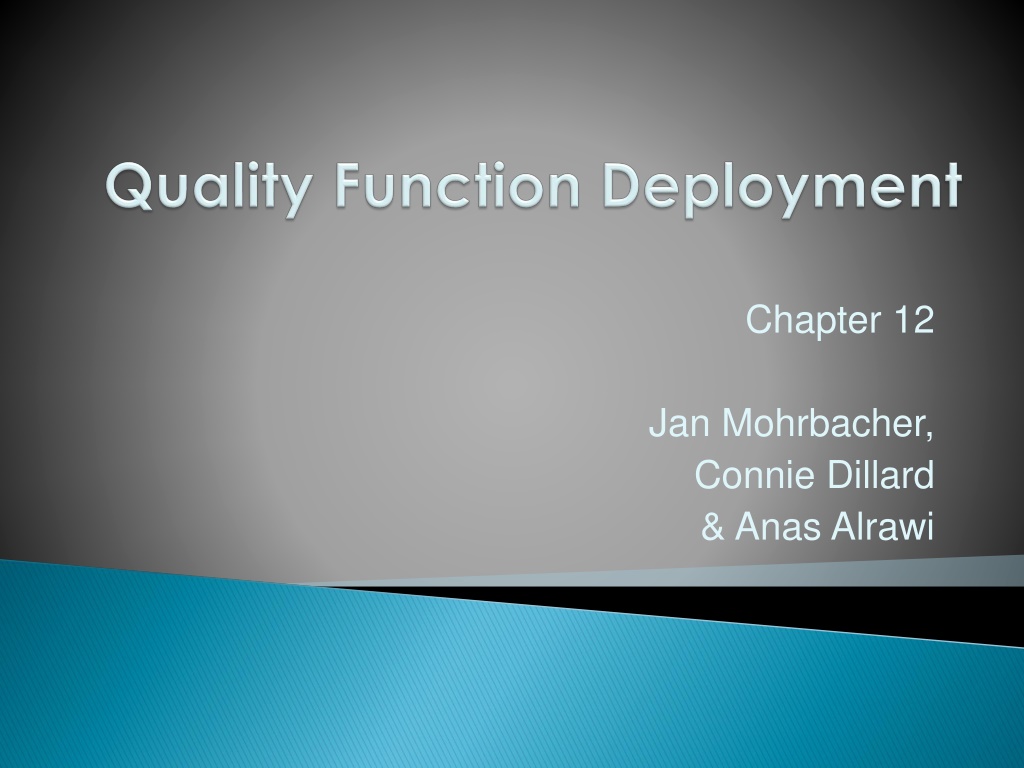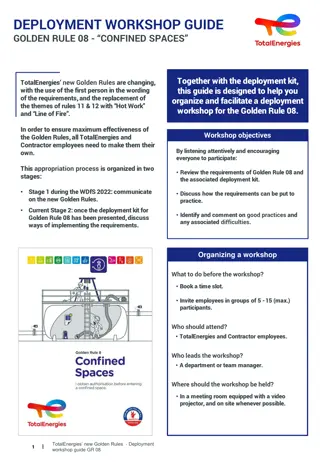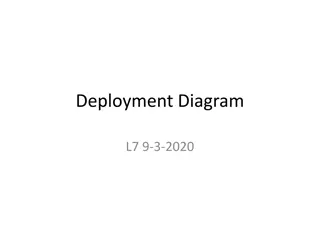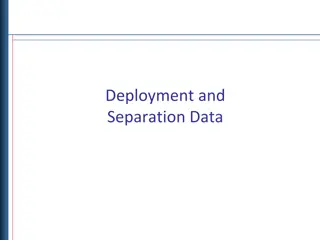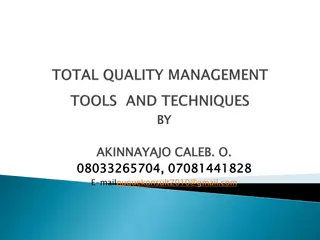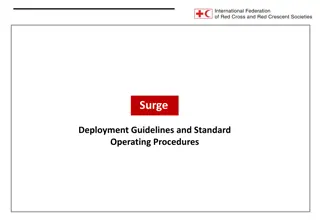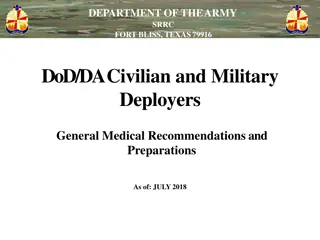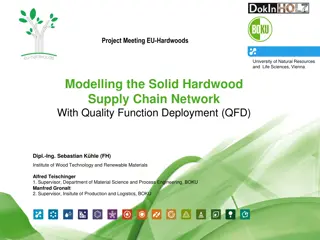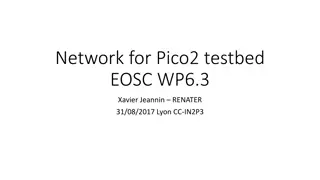Understanding Quality Function Deployment (QFD) and Its Evolution
Quality Function Deployment (QFD) is a strategic quality design method that aims to understand and fulfill customer needs effectively. Originating in Japan in the 1960s, QFD has evolved from Statistical Quality Control (SQC) and Total Quality Control (TQC). It provides a structured approach to product and service development, emphasizing customer satisfaction by aligning business functions to meet common goals. The evolution of QFD, its benefits, historical milestones, and widespread adoption are highlighted in the content.
Download Presentation

Please find below an Image/Link to download the presentation.
The content on the website is provided AS IS for your information and personal use only. It may not be sold, licensed, or shared on other websites without obtaining consent from the author. Download presentation by click this link. If you encounter any issues during the download, it is possible that the publisher has removed the file from their server.
E N D
Presentation Transcript
Chapter 12 Jan Mohrbacher, Connie Dillard & Anas Alrawi
At the conclusion of this class You will have a thorough understanding of: What is QFD? Why it is important? When it is used? How it is used? Understand the function of a QFD Team Realize the Benefits of QFD The Voice of The Customer Organization of information The House of Quality 10. QFD Process 1. 2. 3. 4. 5. 6. 7. 8. 9.
Yoji Akao, a Japanese planning specialist, conceptualized QFD in the 1960 s Dr. Shigeru Mizuno, Professor Emeritus of the Tokyo Institute of Technology is credited with initiated the quality function deployment system
Statistical Quality Control, SQC, was the central quality control activity after WWII. SQC is an effective method of monitoring process using control charts. SQC became Total Quality Control, TQC. QFD was derived from TQC.
1966, Bridgestone Tire Corp first used a process assurance table. 1972, the process assurance table was retooled by Akao to include QFD process. 1972, Kobe Shipyards (of Mitsubishi Heavy Industry) began a QFD Oil Tanker project. 1978, Kobe Shipyards published their quality chart for the tanker.
QFD spread rapidly in North America during the 1980s The Automobile industry and Manufacturing began heavy use of QFD at this time. QFD symposiums (North American, Japanese, European, International) were set up to explore research relating to QFD techniques. The QFD institute was formed in 1994.
Quality Function Deployment is a comprehensive quality design method that: Seeks out spoken and unspoken customer needs from fuzzy Voice of the Customer verbatim; Uncovers "positive" quality that wows the customer; Translates these into designs characteristics and deliverable actions; and Builds and delivers a quality product or service by focusing the various business functions toward achieving a common goal customer satisfaction.
Quality Function Deployment, QFD, is a quality technique which evaluates the ideas of key stakeholders to produce a product which better addresses the customers needs. Customer requirements are gathered into a visual document which is evaluated and remodeled during construction so the important requirements stand out as the end result.
The link between Customer Design Engineer Competitors Manufacturing Provide Insight Into the whole design & manufacturing operation From concept to manufacture (cradle to the grave) Can improve efficiency
A systematic way of documenting and breaking down customer needs into manageable and actionable detail. A planning methodology that organizes relevant information to facilitate better decision making. A way of reducing the uncertainty involved in product and process design. A technique that promotes cross-functional teamwork. A methodology that gets the right people together, early, to work efficiently and effectively to meet customers needs.
Key Thought Quality Function Deployment is a Valuable Decision Support Tool, But it is Not a Decision Maker Throughout
WHAT DOES QFD DO? CONCEPT CUSTOMER Better Designs in Half the Time! Traditional Timeline Plan Design Redesign Manufacture Benefits Plan Design Redesign Manufacture QFD is a Productivity Enhancer
QFD provides the opportunity to make sure you have a good product before you try to design and implement it. It is about planning and problem prevention, not problem solving . QFD provides a systematic approach to identify which requirements are a priority for whom, when to implement them, and why.
QFD is very powerful because it incorporates the voice of customer in the design Resulting in : A better product design A satisfied customer Insight into the design/manufacture operation Improved problem solving and efficiency in production
Ask these important questions Why do QFD? What is the goal? What should its make-up be? Is QFD the right tool ? Is this the right time? Is this the right place to implement? What is success? Who all should be involved?
Poor communications and expectations get lost in the complexity of product development. Lack of structure or logic to the allocation of product development resources. Lack of efficient and / or effective product / process development teamwork. Extended development time caused by excessive redesign, problem solving, or putting out fires.
QFD Team 1. Its function in deployment 2. Two Types of Teams New product design Improving an existing design 3. Cross functional Marketing, design, quality, finance and production
Comprehensive QFD involves Four phases:
6 Quality Function Deployment s House of Quality Correlation Matrix 3 Design Attributes The House The House of Quality of Quality 2 5 1 4 Importance Rankings Relationships between Customer Needs and Design Attributes Customer Perceptions Customer Needs 7 Costs/Feasibility Establishes the Flowdown Relates WHAT'S & HOW'S Ranks The Importance 8 Engineering Measures
The House of Quality Key Elements Informational Elements Two Types of Elements in Each House
QFD Flowdown Manufacturing Environment Software Environment Service Environment Levels Of Granularity Customer Wants Customer Wants Customer Wants Technical Requirements Service Requirements Product Functionality Part Characteristics Service Processes System Characteristics Manufacturing Process Process Controls Design Alternatives Production Requirements Flowdown Relates The Houses To Each Other
Building the House of Quality 1. Identify Customer Attributes 2. Identify Design Attributes / Requirements 3. Relate the customer attributes to the design attributes. 4. Conduct an Evaluation of Competing Products. 5. Evaluate Design Attributes and Develop Targets. 6. Determine which Design Attributes to Deploy in the Remainder of the Process.
1. Identify Customer Attributes These are product or service requirements IN THE CUSTOMER S TERMS. Market Research; Surveys; Focus Groups. What does the customer expect from the product? Why does the customer buy the product? Salespeople and Technicians can be important sources of information both in terms of these two questions and in terms of product failure and repair. OFTEN THESE ARE EXPANDED INTO Secondary and Tertiary Needs / Requirements.
Solicited Unsolicited Quantitative Qualitative Structured Random Focus groups Trade visits Customer visits Consultants Complaint reports Organization standards Government regulations Lawsuits Sales force Training programs Conventions Trade journals Trade shows Vendor Supplier Academic Employees Hot lines Surveys Customer tests Trade trials Prefered costumers OM testing Product purchase survey Customer audits Lagging Leading
Key Elements - Whats What Does The Customer Want Customer Needs CTQs Ys Voice of the Customer
How Important the Whats are TO THE CUSTOMER Customer Ranking of their Needs Key Elements: Customer Requirements Voice of the Customer
2. Identify Design Attributes. Design Attributes are Expressed in the Language of the Designer / Engineer and Represent the TECHNICAL Characteristics (Attributes) that must be Deployed throughout the DESIGN, MANUFACTURING, and SERVICE PROCESSES. These must be MEASURABLE since the Output will be Controlled and Compared to Objective Targets. The ROOF of the HOUSE OF QUALITY shows, symbolically, the Interrelationships between Design Attributes.
Key Elements - Hows How Do You Satisfy the Customer What s Product Requirements Translation For Action X s How s WHAT'S HOW'S Satisfing Customer Needs
Information Correlation Matrix Correlation Matrix Impact Of The How s On Each Other Strong Positive Positive Negative Strong Negative HOW 1 HOW 2 HOW 3 HOW 4 HOW 5 HOW 6 HOW 7 65 45 21 36 8 52 4 H L L M 5 5 3 4 2 4 1 Need 1 Need 2 Need 3 Need 4 Need 5 Need 6 Need 7 H M M L H L M M L H L 3 mils M 8 atm 40 psi 1 mm 12 in. 3 lbs 3 57 41 48 13 50 6 21 Conflict Resolution
3.Relating Customer & Design Attributes Symbolically we determine whether there is NO relationship, a WEAK one, MODERATE one, or STRONG relationship between each Customer Attribute and each Design Attribute. The PURPOSE it to determine whether the final Design Attributes adequately cover Customer Attributes. LACK of a strong relationship between A customer attribute and any design attribute shows that the attribute is not adequately addressed or that the final product will have difficulty in meeting the expressed customer need. Similarly, if a design attribute DOES NOT affect any customer attribute, then it may be redundant or the designers may have missed some important customer attribute.
Key Elements: Relationship Strength of the Interrelation Between the What s and the How s H Strong M Medium L Weak Transfer Function Y = f(X) 9 3 1 HOW 1 H HOW 2 L HOW 3 HOW 4 HOW 5 L HOW 6 HOW 7 M 5 5 3 4 2 4 1 Need 1 Need 2 Need 3 Need 4 Need 5 Need 6 Need 7 H M M L H L M M L H L M Untangling The Web
4. Add Market Evaluation & Key Selling Points This step includes identifying importance ratings for each customer attribute AND evaluating existing products / services for each of the attributes. Customer importance ratings represent the areas of greatest interest and highest expectations AS EXPRESSED BY THE CUSTOMER. Competitive evaluation helps to highlight the absolute strengths and weaknesses in competing products. This step enables designers to seek opportunities for improvement and links QFD to a company s strategic vision and allows priorities to be set in the design process.
5. Evaluate Design Attributes of Competitive Products & Set Targets. This is USUALLY accomplished through in-house testing and then translated into MEASURABLE TERMS. The evaluations are compared with the competitive evaluation of customer attributes to determine inconsistency between customer evaluations and technical evaluations. For example, if a competing product is found to best satisfy a customer attribute, but the evaluation of the related design attribute indicates otherwise, then EITHER the measures used are faulty, OR else the product has an image difference that is affecting customer perceptions. On the basis of customer importance ratings and existing product strengths and weaknesses, TARGETS and DIRECTIONS for each design attribute are set.
Information: How Much Target Values for the How s Note the Units HOW 1 HOW 1 HOW 2 HOW 2 HOW 3 HOW 3 HOW 4 HOW 4 HOW 5 HOW 5 HOW 6 HOW 6 HOW 7 HOW 7 H L L M 65 45 21 36 8 52 4 5 5 3 4 2 4 1 Need 1 Need 2 Need 3 Need 4 Need 5 Need 6 Need 7 H M M L H L M M L H L M 40 psi 3 mils 1 mm 8 atm 12 in. How Much 3 lbs 57 41 48 13 50 6 21 3 Consistent Comparison
Information: Target Direction Information On The HOW'S More Is Better Less Is Better Specific Amount HOW 6 HOW 1 H HOW 2 L HOW 3 HOW 4 HOW 5 L HOW 7 M 65 45 21 36 8 52 4 5 5 3 4 2 4 1 Need 1 Need 2 Need 3 Need 4 Need 5 Need 6 Need 7 H M M L H L M M L H L M 57 41 48 13 50 6 21 The Best Direction
6. Select Design Attributes to be Deployed in the Remainder of the Process This means identifying the design attributes that: have a strong relationship to customer needs, have poor competitive performance, or are strong selling points. These attributes will need to be DEPLOYED or TRANSLATED into the language of each function in the design and production process so that proper actions and controls are taken to ensure that the voice of the customer is maintained. Those attributes not identified as critical do not need such rigorous attention.
Key Elements: Technical Importance Which How s are Key Where Should The Focus Lie CI = Customer Importance Strength is measured on a 9, 3, 1, 0 Scale HOW 1 HOW 2 HOW 3 HOW 4 HOW 5 HOW 6 HOW 7 45 5 5 15 CI 5 3 4 2 4 1 Need 1 Need 2 Need 3 Need 4 Need 5 Need 6 Need 7 45 9 9 3 36 2 6 12 4 36 1 M TI = column (CI *Strength) 57 41 48 13 50 6 21 Ranking The HOW'S
Key Elements: Completeness Are All The How s Captured Is A What Really A How HOW 5 HOW 1 HOW 2 HOW 3 HOW 4 HOW 6 HOW 7 H L L M Need 1 Need 2 Need 3 Need 4 Need 5 Need 6 Need 7 H 5 3 4 2 4 1 M M L H L M M L H L M CC = row (CI *Strength) 57 41 48 13 50 6 21 Have We Captured the HOW'S
Using the House of Quality The voice of the customer MUST be carried THROUGHOUT the production process. Three other houses of quality are used to do this and, together with the first, these carry the customer s voice from its initial expression, through design attributes, on to component attributes, to process operations, and eventually to a quality control and improvement plans. In Japan, all four are used. The tendency in the West is to use only the first one or two.
1 Design Attributes 2 Customer Attributes Component Attributes Attributes 3 Design Process Operations Component 4 Quality Control Plan Attributes The How s at One Level Become the What s at the Next Level
Voice of the customer (VOC) The efforts to investigate and analyze the customer. With QFD, VOC data is reduce into a set of critical customer needs using techniques such as affinity, diagrams, function analysis, etc, defined and documented in customer needs data dictionary, and prioritized. This VOC effort is also the opportunity to recognize unfulfilled needs that can be provided at minimum, competitive advantage and potentially, a break-through product or true value innovation
The Cascading Voice of the Customer NOTES: Design Attributes are also called Functional Requirements Component Attributes are also called Part Characteristics Process Operations are also called Manufacturing Processes and the Quality Control Plan refers to Key Process Variables. Y Critical to Quality Characteristics (CTQs) Key Manufacturing Processes X Key Process Variables
10 Minute Break
Class Activity: Building a House of Quality
Improves customer satisfaction Reduces implementation time Promotes team work Provides documentation
Creates focus on customer requirements Uses competitive information effectively Prioritizes resources Identifies items that can be acted upon Structures resident experience/information Improves customer satisfaction Decreases midstream design changes Limits post introduction problems Avoids future development redundancies Identifies future application opportunities Surfaces missing assumptions Reduces implementation time Based on consensus Creates communication at interfaces Identifies actions at interfaces Creates global view out of details Promotes teamwork Documents rational for design Is easy to assimilate Adds structure to the information Adapts to changes (living document) Provides framework for sensitivity analysis Provides documentation
QFD On Everything Set the Right Granularity Don t Apply To Every Last Project Inadequate Priorities Lack of Teamwork Wrong Participants Lack of Team Skills Lack of Support or Commitment Too Much Chart Focus Hurry up and Get Done Failure to Integrate and Implement QFD Common QFD Pitfalls
Review Current Status At Least Quarterly Monthly on 1 Yr Project Weekly on Small Projects HOW 1 HOW 2 HOW 3 HOW 4 HOW 5 HOW 6 HOW 7 H L L M 65 45 21 36 8 52 4 5 5 3 4 2 4 1 Need 1 Need 2 Need 3 Need 4 Need 5 Need 6 Need 7 H M M L H The Static QFD L M H M L L 3 mils M 8 atm 40 psi 1 mm 12 in. 3 lbs 3 57 41 48 13 50 6 21
Points to Remember The process may look simple, but requires effort. Many entries look obvious after they re written down. If there are NO tough spots the first time: It Probably Isn t Being Done Right!!!! Focus on the end-user customer. Charts are not the objective. Charts are the means for achieving the objective. Find reasons to succeed, not excuses for failure. Remember to follow-up afterward
